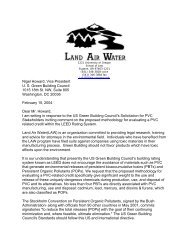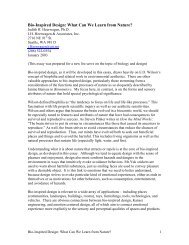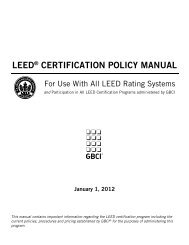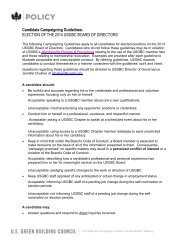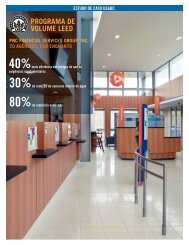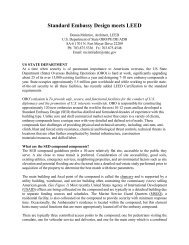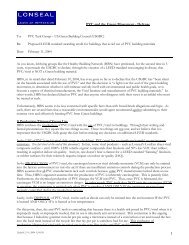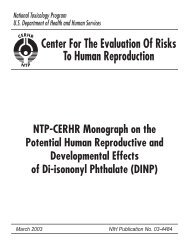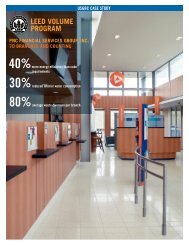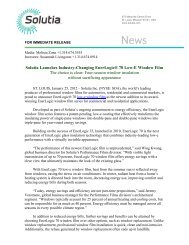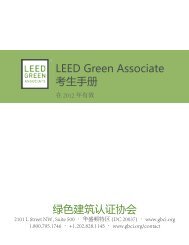The Costs and Financial Benefits of Green Buildings - US Green ...
The Costs and Financial Benefits of Green Buildings - US Green ...
The Costs and Financial Benefits of Green Buildings - US Green ...
Create successful ePaper yourself
Turn your PDF publications into a flip-book with our unique Google optimized e-Paper software.
<strong>The</strong> <strong>Costs</strong> <strong>and</strong> <strong>Financial</strong> <strong>Benefits</strong> <strong>of</strong> <strong>Green</strong> <strong>Buildings</strong>Greg Kats, Principal <strong>of</strong> Capital E, <strong>and</strong> Chair <strong>of</strong> LEED E&A TAG1828 L Street NW, Suite 1046Washington DC 20036202 463-8469gkats@cap-e.comwww.cap-e.comEXECUTIVE SUMMARYThis paper provides a brief review <strong>of</strong> what is known about the costs <strong>and</strong> financial benefits<strong>of</strong> green buildings. This paper draws directly <strong>and</strong> predominantly from a recent reportdeveloped for 40+ California agencies, <strong>and</strong> written in partnership with the <strong>US</strong> <strong>Green</strong>Building Council. (Kats et al., 2003). <strong>The</strong> bulk <strong>of</strong> this paper focuses on reviewing <strong>and</strong>analyzing existing studies <strong>and</strong> data about the costs <strong>and</strong> financial benefits <strong>of</strong> greenbuildings. <strong>The</strong> benefits <strong>of</strong> building green include reduced energy, water <strong>and</strong> waste costs;reduced emissions; lower operations <strong>and</strong> maintenance costs; lower insurance <strong>and</strong> riskcosts; <strong>and</strong> enhanced productivity <strong>and</strong> health. <strong>The</strong> additional costs <strong>of</strong> associated withgreen buildings are about 2%, while the financial benefits are about 10 times as large.INTRODUCTIONUntil the report that this paper draws from was commissioned by California’s SustainableBuilding Task Force, no comprehensive study <strong>of</strong> the actual costs <strong>and</strong> financial benefits <strong>of</strong>green buildings had been undertaken. This is surprising because buildings consume alarge portion <strong>of</strong> water, wood, energy <strong>and</strong> other resources used in the economy, includingabout 2/3 <strong>of</strong> electricity, <strong>and</strong> provide a potentially promising way to help address a range<strong>of</strong> challenges, such as:• <strong>The</strong> high cost <strong>of</strong> electric power.• Worsening grid constraints, with associated power quality <strong>and</strong> availabilityproblems.• A growing water shortage.• Continued state <strong>and</strong> federal pressure to cut criteria pollutants.• Growing concern over the cost <strong>of</strong> global warming.• <strong>The</strong> rising incidence <strong>of</strong> allergies <strong>and</strong> asthma, especially in children.In September 2002, California’s Sustainable <strong>Buildings</strong> Task Force (SBTF) 1 – composed<strong>of</strong> representatives from over 40 state agencies – with funding from seven <strong>of</strong> its1 See: http://www.ciwmb.ca.gov/<strong>Green</strong>Building/TaskForce/, State <strong>of</strong> California Sustainable Building TaskForce website.
constituent agencies, 2 hired a team, lead by Capital E, to evaluate the cost <strong>and</strong> benefits <strong>of</strong>sustainable building. <strong>The</strong> analysis was intended to be conducted in two phases. Phase Iwould entail a broad literature review <strong>of</strong> the current knowledge <strong>and</strong> research completedto date around the costs <strong>and</strong> benefits <strong>of</strong> green building, followed by a gap analysis,intended to inform Phase II analysis. Capital E, hired to lead the first phase - withsupport <strong>of</strong> the Task Force – also undertook the second phase <strong>of</strong> work, synthesizing <strong>and</strong>writing the full report analyzing <strong>of</strong> the full financial costs <strong>and</strong> benefits <strong>of</strong> green buildings3 . Fifty members <strong>of</strong> the California Sustainable Building Task Force provided guidance<strong>and</strong> significant staff <strong>and</strong> research time to shape this work. Although written with specificregard to California state buildings, the conclusions are broadly applicable both to othertypes <strong>of</strong> buildings <strong>and</strong> for other states.<strong>The</strong>re is an increasingly broad recognition <strong>of</strong> the wider benefits <strong>of</strong> the green buildings.For example, the <strong>US</strong> Air Force <strong>and</strong> Navy require that its new buildings be LEED greenbuildings, in part because they recognize the linkage between wasteful energyconsumption <strong>and</strong> the exposure <strong>of</strong> <strong>US</strong> military forces to military confrontation related tooil resources.Some benefits, such as reduced energy bills, are easily quantified, while most benefits -such as impact on health or security - are usually neither quantified nor explicitlyconsidered in making decisions about building design. <strong>The</strong> intent <strong>of</strong> the California studywas to seek to quantify <strong>and</strong> document in a rigorous way as many significant costs <strong>and</strong>benefits as possible to determine a realistic assessment <strong>of</strong> the current costs <strong>and</strong> benefits <strong>of</strong>green design. Doing so requires the quantification in today’s dollars <strong>of</strong> the stream <strong>of</strong>current <strong>and</strong> future benefits <strong>and</strong> costs. This requires making explicit choices aboutdiscount rate <strong>and</strong> appropriate term to derive an informed rationale for making sustainablebuilding funding decisions.• Discount Rate <strong>The</strong> discount rate used is 5% real – that is, 5% plus inflation<strong>and</strong> is generally lower than the public cost <strong>of</strong> capital, <strong>and</strong> representative <strong>of</strong>rates used by public sector entities. 4• Term <strong>Buildings</strong> typically operate for 30-60 years. Different energy systems<strong>and</strong> technologies last for different lengths <strong>of</strong> time – some energy equipment isupgraded every 8 to 15 years while some building energy systems may last thelife <strong>of</strong> a building. This report conservatively assumes the benefits will last 20years, or less than the average between envelope <strong>and</strong> equipment expected life.2 <strong>The</strong> seven CA state agencies that funded this study are: Air Resources Board, California Integrated WasteManagement Board , Department <strong>of</strong> Finance, Department <strong>of</strong> General Services, Department <strong>of</strong>Transportation (CalTrans), Department <strong>of</strong> Water Resources, <strong>and</strong> Division <strong>of</strong> the State Architect.3 This report was a collaborative effort made possible through the contributions <strong>of</strong> Capital E, FutureResources Associates, the Sustainable Building Task Force, <strong>and</strong> the United States <strong>Green</strong> Building Council.<strong>The</strong> <strong>US</strong> <strong>Green</strong> Building Council served as a partner in this effort, providing critical data, insights <strong>and</strong>support throughout the project. Capital E assembled a distinguished advisory group that provided criticalguidance to the project comprised <strong>of</strong>: Gregg Ander, Bob Berkebile, Anthony Bernheim, Steve Castellanos,Christine Ervin, Vivian L<strong>of</strong>tness, Roger Platt, Bill Reed, Art Rosenfeld, <strong>and</strong> Beth Shearer4 <strong>The</strong> Wall Street Journal lists discount rates daily, dependent upon credit rating. See Market Data <strong>and</strong>Resources. Available at: http://online.wsj.com/public/site_map?page=Site+Map.2
• Inflation Rate <strong>of</strong> inflation is assumed to be 2% per year, in line with mostprojections.<strong>The</strong>se assumptions are used to determine the net present value <strong>of</strong> the financial benefitsassociated with green buildings, in turn providing a basis to compare with the additionalcosts associated with building green. <strong>Green</strong> buildings are defined in this paper as LEEDor LEED equivalent.COST OF GREEN BUILDINGSCost data was gathered on 33 individual LEED registered projects (25 <strong>of</strong>fice buildings<strong>and</strong> 8 school buildings) with actual or projected dates <strong>of</strong> completion between 1995 <strong>and</strong>2004. <strong>The</strong>se 33 projects were chosen because we were able to secure relatively solid costdata for both actual green design <strong>and</strong> for the comparable cost for the same building with aconventional design. A larger number <strong>of</strong> additional buildings were evaluated but left out<strong>of</strong> this analysis because <strong>of</strong> inadequate data. <strong>The</strong> average cost premium for these greenbuildings was almost 2%, or about $5 per ft2. Data indicate that cost <strong>of</strong> green buildingsdeclines as public or private entities undertake multiple green buildings.FINANCIAL BENEFITS OF GREEN BUILDINGSMajor financial benefits include: reduced energy, water <strong>and</strong> waste costs; reducedemissions; reduced risk <strong>and</strong> insurance costs; lower operations <strong>and</strong> maintenance costs; <strong>and</strong>enhanced productivity <strong>and</strong> health, <strong>and</strong> each <strong>of</strong> these are briefly discussed in turn.Energy<strong>Green</strong> design reduces environmental <strong>and</strong> health costs associated with air pollution fromenergy use, but these benefits are generally not counted or included in investmentdecisions. This paper examines some <strong>of</strong> these benefits, including the value <strong>of</strong> peakpower reduction <strong>and</strong> the value <strong>of</strong> emissions reductions.On average, green buildings are 28% more efficient than conventional buildings <strong>and</strong>generate 2% <strong>of</strong> their power on-site, typically from photovoltaics.Table 1. Reduced Energy Use in <strong>Green</strong> <strong>Buildings</strong> as Compared withConventional <strong>Buildings</strong>Certified Silver Gold AverageEnergy Efficiency (abovest<strong>and</strong>ard code) 18% 30% 37% 28%On-Site Renewable Energy 0% 0% 4% 2%<strong>Green</strong> Power 10% 0% 7% 6%Total 28% 30% 48% 36%Source: <strong>US</strong>GBC, Capital E Analysis3
Evaluation <strong>of</strong> LEED submission documentation for a dozen buildings, shows an averagereduction in energy use <strong>of</strong> 30%, but an average peak reduction <strong>of</strong> about 40%. While thedata set is limited, it nonetheless indicative. Commercial air conditioning <strong>and</strong> commerciallighting –together represent about a quarter <strong>of</strong> peak load (Wilson et al., 2002). LEEDdesign typically sharply cuts these peak dem<strong>and</strong> uses due to technologies <strong>and</strong> designelements such as:• High Performance Lighting: more efficient lights, task lighting, use <strong>of</strong> sensors• Increased Ventilation Effectiveness: helps cut air conditioning load during peak• Commissioning: tends to increase building system performance <strong>and</strong> cut energy use• Heat Isl<strong>and</strong> Reduction Measures: lower building <strong>and</strong> urban temperatures, in turnreducing air conditioning loads <strong>and</strong> peak dem<strong>and</strong>.• On-site Generation <strong>of</strong> electricity (PV is highly coincident with peak)<strong>Green</strong> building energy savings primarily come from reduced electricity purchases, <strong>and</strong>secondarily from reduced peak energy dem<strong>and</strong>. <strong>The</strong> financial benefits <strong>of</strong> 30% reducedconsumption at an average California electricity price <strong>of</strong> $0.11/kWh are about$0.44/ft 2 /yr, with a 20-year NPV (net present value) <strong>of</strong> $6.71/ft 2 . <strong>The</strong> additional value <strong>of</strong>peak dem<strong>and</strong> reduction from green buildings is estimated at $0.025/ft 2 /yr, with 20-yearNPV $0.38/ft 2 . Together, the total 20-year NPV <strong>of</strong> financial energy benefits from atypical green building is about $7/ft 2 . Thus, on the basis on energy savings alone,investing in green buildings appears to be cost-effective.Emissions ReductionsAir pollution from burning fossil fuels to generate electricity imposes very large health,environmental <strong>and</strong> property damage costs. Demonstrated health costs include increasedmortality <strong>and</strong> increased respiratory ailments. 5 <strong>The</strong> health, environment <strong>and</strong> propertydamages associated with pollution from burning fossil fuels – commonly referred to asexternalities – are only partially reflected in the price <strong>of</strong> energy. Some <strong>of</strong> the mostharmful emissions include NOx, SOx, PM10 <strong>and</strong> CO2. For some pollutants, includingNOx <strong>and</strong> SOx, there is a well-established, liquid trading market <strong>and</strong> these market pricesserve as our best currently available measure <strong>of</strong> both the marginal cost <strong>of</strong> emissionsreductions <strong>and</strong> the value society places on them.<strong>The</strong> vast majority <strong>of</strong> the world’s climate change scientists have concluded thatanthropogenic emissions – principally from burning fossil fuels – are the dominant cause<strong>of</strong> global warming (IPCC, 2001). <strong>The</strong> building sector is responsible for about 35% <strong>of</strong> <strong>US</strong>CO2 emissions, <strong>and</strong> as a recent study notes, <strong>US</strong> buildings alone are responsible for moreCO2 emissions than the entire national emissions <strong>of</strong> any other country in the worldexcept China (Kinzey et al., 2002). CO2 trading programs in the <strong>US</strong> are emerging, 6 with5 See, for example: “<strong>The</strong> <strong>Benefits</strong> <strong>and</strong> <strong>Costs</strong> <strong>of</strong> Clean Air Act 1990 to 2010,” 1991. Available at:http://www.epa.gov/air/sect812/1990-2010/fullrept.pdf <strong>and</strong> Jonathan Samet et al., “<strong>The</strong> NationalMorbidity, Mortality, <strong>and</strong> Air Pollution Study – Part II: Morbidity <strong>and</strong> Mortality From Air Pollution In theUnited States,” Health Effects Institute, 2000. Available at: http://www.healtheffects.org/Pubs/Samet2.pdf.6 Carbon Trade Watch. Briefing No. 1: <strong>The</strong> Sky is Not the Limit: <strong>The</strong> Emerging Market in <strong>Green</strong>houseGases. January 2003. Available at: http://www.tni.org/reports/ctw/sky.pdf. For a list <strong>of</strong> existing registry4
the value <strong>of</strong> trades typically ranging from under $1 up to $16 per ton, with most trades atunder $5 per ton, but with a general trend <strong>of</strong> prices rising.Table 2. 20-Year NPV <strong>of</strong> 36% Pollution Reduction (/ft 2 )CO2 PRICEPollutant $5/ton $10/tonNOx $0.66 $0.66PM10 $0.51 $0.51SOx $0.20 $0.20CO2 $0.11 $0.22Total $1.48 $1.59Source: Capital E AnalysisBased on California market prices for NOx, PM10, SOx <strong>and</strong> an assumed value <strong>of</strong> CO2 <strong>of</strong>$5 per ton value <strong>of</strong> carbon, the 20-year NPV for emissions reductions from greenbuildings is estimated at $1.48/ft 2 . This does not include the health, property <strong>and</strong>environmental costs value <strong>of</strong> important additional emissions such as mercury, <strong>and</strong> hencewould tend to underestimate the value <strong>of</strong> reduced energy use from green design.Health <strong>and</strong> Productivity <strong>Benefits</strong><strong>The</strong>re is growing recognition <strong>of</strong> the large health <strong>and</strong> productivity costs imposed by poorindoor environmental quality (IEQ) in commercial buildings – estimated variously at upto hundreds <strong>of</strong> billions <strong>of</strong> dollars per year. This is not surprising as people spend 90% <strong>of</strong>their time indoors, <strong>and</strong> the concentration <strong>of</strong> pollutants indoors is typically higher thanoutdoors, sometimes by as much as 10 or even 100 times. 7 <strong>The</strong> costs <strong>of</strong> poor indoorenvironmental <strong>and</strong> air quality – including higher absenteeism <strong>and</strong> increased respiratoryailments, allergies <strong>and</strong> asthma – are hard to measure <strong>and</strong> have <strong>of</strong>ten been “hidden” in sickdays, lower productivity, unemployment insurance <strong>and</strong> medical costs.However there are over a thous<strong>and</strong> studies <strong>and</strong> reports linking green building attributessuch as air quality <strong>and</strong> thermal comfort on human health <strong>and</strong> productivity. For example,• A National Science <strong>and</strong> Technology Council project entitled Indoor Health &Productivity developed a database contains over 900 papers from more than 100journals <strong>and</strong> conferences. <strong>The</strong>re are abstracts for about 700 <strong>of</strong> these articles, <strong>and</strong> theentire database is searchable by such fields as author <strong>and</strong> category (e.g., acoustics,<strong>and</strong> emissions reductions programs, see also:http://www.nescaum.org/<strong>Green</strong>house/Registry/state_matrix.html.7 “Indoor Air Quality,” <strong>US</strong> Environmental Protection Agency. January 6, 2003. Available at:http://www.epa.gov/iaq/.5
humidity, ventilation) or by keywords such as sick building, visual comfort orHVAC. 8• Two studies <strong>of</strong> over 11,000 workers in 107 European buildings analyzed the effect <strong>of</strong>worker-controlled temperature <strong>and</strong> ventilation. <strong>The</strong>y found significantly reducedillness symptoms, reduced absenteeism <strong>and</strong> increases in perceived productivity overworkers in a group that lacked these features (Heerwagen, 2002).• One <strong>of</strong> the leading national centers <strong>of</strong> expertise on the benefits <strong>of</strong> high performancebuildings is the Center for Building Performance at Carnegie Mellon University. <strong>The</strong>Center’s Building Investment Decision Support (BIDS) program has reviewed over1000 studies that relate technical characteristics <strong>of</strong> buildings, in areas such as lighting<strong>and</strong> ventilation, to tenant responses, such as productivity. 9Collectively, these studies demonstrate that better building design <strong>and</strong> performance inareas such as lighting, ventilation <strong>and</strong> thermal control correlate to increases intenant/worker well-being <strong>and</strong> productivity. Rigorous reviews <strong>of</strong> published data byCarnegie Mellon, for example, demonstrate that increases in tenant control overventilation, temperature <strong>and</strong> lighting each provide measured benefits from 0.5% up to34%, with average measured workforce productivity gains <strong>of</strong> 7.1% with lighting control,1.8% with ventilation control, <strong>and</strong> 1.2% with thermal control. Additionally, significantmeasured improvements have been found with increased daylighting.LEED is designed to specifically address building materials, design <strong>and</strong> operationsaffecting the productivity <strong>and</strong> health issues discussed above. Credits directly relating tohealth <strong>and</strong> comfort are included in the Indoor Environmental Quality section with twoprerequisites <strong>and</strong> 15 credits (about 22% <strong>of</strong> total LEED credits available) as well asprerequisites <strong>and</strong> credits in other sections including energy <strong>and</strong> atmosphere, <strong>and</strong>materials. Gold <strong>and</strong> Platinum level LEED buildings are more comprehensive in applyingIEQ-related measures <strong>and</strong> therefore should be viewed as providing larger productivity<strong>and</strong> health benefits than Bronze or Silver level green buildings.Given the studies <strong>and</strong> data reviewed above, a 1% productivity <strong>and</strong> health gain in Bronze<strong>and</strong> Silver level buildings <strong>and</strong> a 1.5% gain to Gold <strong>and</strong> Platinum level buildings appearsprudent. <strong>The</strong>se percentages are at the low end <strong>of</strong> the range <strong>of</strong> productivity gains for each<strong>of</strong> the individual specific building measures – ventilation, thermal control, light control<strong>and</strong> daylighting – referenced above.For state <strong>of</strong> California employees, a 1% increase in productivity (equal to about 5minutes per working day) is equal to $665 per employee per year, or $2.96/ft 2 per year. 10A 1.5 % increase in productivity (or a little over 7 minutes each working day) is equal to$998 per worker per $4.44/ft 2 per year. At $4.44 per year, over 20 years <strong>and</strong> at a 5%discount rate [assuming that state employee salaries are unchanged (that is, rise at the rate8 An online bibliography as well as more information about this project can be found athttp://www.dc.lbl.gov/IHP/..9 See: www.arc.cmu.edu/cbpd/10 Average 2002 California employee compensation is $66,469 <strong>and</strong> average space per employee is 225 ft 2 .Both numbers are discussed more fully in the California Report.6
<strong>of</strong> inflation)], the NPV <strong>of</strong> the productivity benefits is estimated at about $45/ft 2 forCertified <strong>and</strong> Silver level buildings, <strong>and</strong> $67/ft 2 for Gold <strong>and</strong> Platinum level buildings.Reduced Cost <strong>of</strong> Operations <strong>and</strong> MaintenanceLEED includes prerequisites <strong>and</strong>/or credits for commissioning <strong>and</strong> metering, both <strong>of</strong>which contribute to reducing building operations <strong>and</strong> maintenance costs. <strong>The</strong>re is agrowing body <strong>of</strong> data demonstrating that commissioning helps eliminate costly changeorders, reduces requests for cost information <strong>and</strong> call backs, helps ensure propersystem/component selection <strong>and</strong> helps improve performance <strong>of</strong> building systems (Dorganet al., 2002). Detailed analysis <strong>of</strong> several hundred million dollars <strong>of</strong> energy buildingupgrades demonstrate that rigorous measurement <strong>and</strong> verification <strong>of</strong> energy <strong>and</strong> waterefficiency <strong>and</strong> system retr<strong>of</strong>its tend to:• Increase initial savings level.• Increase persistence <strong>of</strong> savings.• Reduce variability <strong>of</strong> energy <strong>and</strong> water savings. (Kats et al., 1997)Commissioning <strong>and</strong> improved metering allows building mangers to better manageupgrades <strong>and</strong> maintenance, helping to anticipate <strong>and</strong> avoid equipment failure, leaks <strong>and</strong>other costly operations <strong>and</strong> maintenance (O&M) problems. Thus, commissioning <strong>and</strong>metering contribute to lower O&M costs, such as extending equipment life. O&M costsin California state buildings are about $3000 per person per year, or nearly an order <strong>of</strong>magnitude larger than energy costs, so any reduction in O&M costs has a significantimpact on financial benefits. <strong>The</strong>re is insufficient data to estimate with any precision thereduction in O&M costs that occurs in green buildings. It is conservatively estimated thatgreen buildings experience an O&M cost decline <strong>of</strong> 5% per year. This equals a savings<strong>of</strong> $0.68/ft2 per year, for a 20-year NPV <strong>of</strong> about $10/ft 2 .Insurance <strong>and</strong> Risk Management <strong>Benefits</strong> <strong>of</strong> <strong>Green</strong> <strong>Buildings</strong><strong>Green</strong> building design <strong>and</strong> technologies <strong>of</strong>fer many insurance <strong>and</strong> risk reduction benefits,including: 11* Property Loss Prevention, Health & Safety (eg lower workmen’s compensationcosts, reduced likelihood <strong>of</strong> moisture damage, etc. )* Liability Loss Prevention (reduced business interruption risks –eg fromunplanned power outages), <strong>and</strong>* Natural Disaster Preparedness <strong>and</strong> Recovery (green buildings are lessvulnerable to natural disasters, especially heat catastrophes) (Mills, 2003).A more specific characterization <strong>of</strong> the potential insurance benefits <strong>of</strong> green buildings aremapped onto the credits <strong>of</strong> the LEED in the California Report. Each LEED prerequisite<strong>and</strong> credit is evaluated against seven types <strong>of</strong> risk – property loss; general liability;11 Insurance work drawn from Report By LBNL Senior Scientist Evan Mills, <strong>Green</strong> buildings as a Risk-Management Strategy, Prepared for Capital-E, December 19, 2002 (And part <strong>of</strong> the California Report)Extensive discussion <strong>and</strong> references on the subject can be found athttp://eetd.lbl.gov/ea/mills/insurance/cifram.html7
usiness interruption; vehicular; health & workers comp; life; <strong>and</strong> environmentalliability; along with related comments. Of the 64 LEED points possible in the LEEDdesign areas (excluding the Innovation <strong>and</strong> Design Process category, which is nonspecific),49 (77%) are associated with measures that have potential risk-managementbenefits.Although the financial benefits <strong>of</strong> risk <strong>and</strong> insurance loss reduction <strong>of</strong> green buildingsappear substantial, this report did not seek to estimate the financial value <strong>of</strong> thesebenefits. Additional research <strong>and</strong> analysis could probably provide reasonable estimates.Additional Sources <strong>of</strong> <strong>Financial</strong> <strong>Benefits</strong>Additional smaller levels <strong>of</strong> savings are provided by reductions in water use, reducedwaste, <strong>and</strong> the energy, materials <strong>and</strong> health benefits from application <strong>of</strong> lighter coloredro<strong>of</strong>s <strong>and</strong> surfaces. (Extensive studies by Lawrence Berkeley National Laboratory, theCalifornia Energy Commission <strong>and</strong> others have documented large energy <strong>and</strong> healthbenefits from lighter color ro<strong>of</strong>s, lighter color paving <strong>and</strong> tree planting. Darker surfacesabsorb more sunlight, increasing temperature within buildings <strong>and</strong> creating “heat isl<strong>and</strong>s”<strong>and</strong> an associated need for air conditioning. More air conditioning requires greaterconsumption <strong>of</strong> energy, which in turn leads to the release <strong>of</strong> more pollutants).CONCL<strong>US</strong>IONSMany <strong>of</strong> the financial benefits estimated in this report are general financial benefits,rather than benefits that accrue to a specific building tenant or owner. While agovernment entity should care about the benefits their building may have for society, aprivate commercial entity may not. Private sector building owners, for example, may beless likely to care about health <strong>and</strong> environmental impacts, <strong>and</strong> hence might perceivesignificantly lower financial benefits <strong>of</strong> building green. In addition, because <strong>of</strong> highercapital costs <strong>and</strong> hurdle rates, future financial benefits are discounted more heavily byprivate entities than by public ones, further reducing the perceived value <strong>of</strong> future greenbuilding financial benefits for the private sector. <strong>The</strong>se differences in large part explainthe significant disparity between public <strong>and</strong> private sector adoption <strong>of</strong> green buildingdesign.This paper began with a review <strong>of</strong> data on actual or modeled costs for 33 green buildings.Largely derived from several dozen conversations with architects, developers <strong>and</strong> others,the data indicates that the construction cost premium for green buildings is almost 2%,substantially less than is generally perceived.<strong>The</strong> body <strong>of</strong> this paper focused on the financial benefits <strong>of</strong> a range <strong>of</strong> green buildingattributes, with the findings summarized below.8
Table 3. Summary <strong>of</strong> Findings (per ft 2 )20-yearCategoryNPVEnergy Value $7.09Emissions Value $1.48Water Value $0.58Waste Value $0.15Commissioning O&M Value $10.27Productivity <strong>and</strong> Health Value (Bronze <strong>and</strong> Silver) $44.94Productivity <strong>and</strong> Health Value (Gold <strong>and</strong> Platinum) $67.42Total (Bronze <strong>and</strong> Silver) $70.59Total (Gold <strong>and</strong> Platinum) $93.06Source: Capital E Analysis<strong>The</strong> relatively large impact <strong>of</strong> productivity <strong>and</strong> health gains reflects the fact that the direct<strong>and</strong> indirect costs <strong>of</strong> employees are far larger than the costs <strong>of</strong> buildings or operationalcosts, so even small increases in employee productivity translate into large benefits. Assummarized above, total financial benefits <strong>of</strong> green design are estimated to be $70/ft 2 forBronze <strong>and</strong> Silver level green buildings, <strong>and</strong> $90/ft 2 for Gold <strong>and</strong> Platinum levelbuildings, equal to 20% <strong>of</strong> building construction costs. <strong>The</strong> financial benefits are foundto be over ten times larger than the 2% green cost premium.<strong>The</strong> conclusions above indicate that while green buildings generally cost more thanconventional buildings, the “green premium” is lower than is commonly perceived. <strong>The</strong>cost <strong>of</strong> green buildings tends to decline with experience in design <strong>and</strong> development, asclients <strong>and</strong> their design <strong>and</strong> architecture teams get beyond their first green building.9
REFERENCESChad Dorgan, Robert Cox <strong>and</strong> Charles Dorgan, “<strong>The</strong> Value <strong>of</strong> the CommissioningProcess: <strong>Costs</strong> <strong>and</strong> <strong>Benefits</strong>”, Farnsworth Group, Madison WI, paper presented at the2002 <strong>US</strong> <strong>Green</strong> Building Council Conference, Austin, Texas. Available at:http://www.usgbc.org/expo2002/schedule/documents/DS506_Dorgan_P152.pdf.Judith Heerwagen, “Sustainable Design Can Be an Asset to the Bottom Line - exp<strong>and</strong>edinternet edition,” Environmental Design & Construction, Posted 07/15/02. Available at:http://www.edcmag.com/CDA/ArticleInformation/features/BNP__Features__Item/0,4120,80724,00.html.Intergovernmental Panel on Climate Change (IPCC) . World Meteorological Association<strong>and</strong> United Nations Environmental Program. IPCC Third Assessment Report – ClimateChange 2001. Available at: http://www.ipcc.ch/Greg Kats, Art Rosenfeld, <strong>and</strong> Scott McGaraghan, “Energy Efficiency as a Commodity:<strong>The</strong> Emergence <strong>of</strong> a Secondary Market for Efficiency Savings in Commercial <strong>Buildings</strong>,”1997 ECEEE Conference Proceedings. Available at:http://www.ipmvp.org/info/ece397.pdf.Greg Kats, Principal Author. Contributing Authors: Leon Alevantis (DGS), AdamBerman (Capital E), Evan Mills (LBNL), <strong>and</strong> Jeff Perlman (Capital E), “<strong>The</strong> <strong>Costs</strong> <strong>and</strong><strong>Financial</strong> <strong>Benefits</strong> <strong>of</strong> <strong>Green</strong> <strong>Buildings</strong>”, A Report to California’s Sustainable BuildingTask Force, August 2003Bruce Kinzey, Sonny Kim, <strong>and</strong> John D. Ryan, “<strong>The</strong> Federal <strong>Buildings</strong> Research <strong>and</strong>Development Program: A Sharp Tool for Climate Policy,” 2002 ACEEE proceedings,Section 9.21Evan Mills, “Climate Change, <strong>Buildings</strong>, <strong>and</strong> the Insurance Sector: TechnologicalSynergisms between Adaptation <strong>and</strong> Mitigation,” Building Research <strong>and</strong> Information (inpress), 2003. Available at: http://eetd.lbl.gov/emills/PUBS/Mitigation_Adaptation.html.John Wilson, Art Rosenfeld <strong>and</strong> Mike Jaske, “Using Dem<strong>and</strong> Responsive Loads to MeetCalifornia’s Reliability Needs,” paper presented at 2002 ACEEE summer conference.Available from: jwilson@energy.state.ca.us.10



